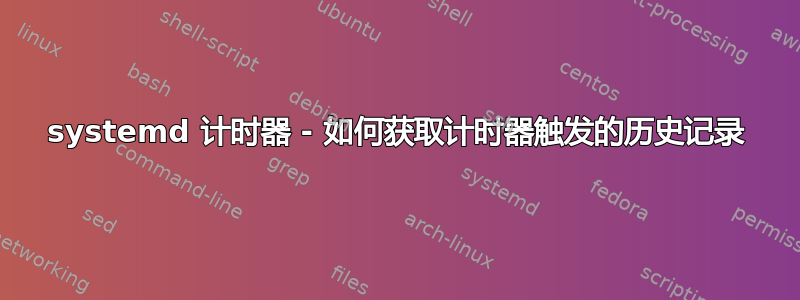
systemctl status mytimer.timer
告诉我它何时处于活动状态以及下一次触发何时到期。如何获取过去计时器触发时间的列表?
答案1
列出计时器,并显示日志/日志单元历史记录:
systemctl list-timers
# replace motd-news with mytimer
journalctl -u motd-news.timer
输出:
-- Logs begin at Fri 2018-11-02 13:17:39 CDT, end at Sat 2018-11-03 11:20:59 CDT. --
Nov 02 13:17:52 pop-os systemd[1]: Started Message of the Day.
Nov 02 18:45:46 pop-os systemd[1]: Stopped Message of the Day.
-- Reboot --
Nov 02 18:46:47 pop-os systemd[1]: Started Message of the Day.
-- Reboot --
Nov 03 07:57:27 pop-os systemd[1]: Started Message of the Day.
其他一些有用的标志:
--since开始时间到当前时间--until与since一起使用将得到一个时间范围--reverse首先显示最新的--grepgrep 消息中的模式
获取时间的其他感兴趣的标志将使用该--output标志以及--output-field标志 f
-o, --output= 控制显示的日记条目的格式。采用以下选项之一:
short is the default and generates an output that is mostly identical to the formatting of classic syslog files, showing one line per journal entry. short-full is very similar, but shows timestamps in the format the --since= and --until= options accept. Unlike the timestamp information shown in short output mode this mode includes weekday, year and timezone information in the output, and is locale-independent. short-iso is very similar, but shows ISO 8601 wallclock timestamps. short-iso-precise as for short-iso but includes full microsecond precision. short-precise is very similar, but shows classic syslog timestamps with full microsecond precision. short-monotonic is very similar, but shows monotonic timestamps instead of wallclock timestamps. short-unix is very similar, but shows seconds passed since January 1st 1970 UTC instead of wallclock timestamps ("UNIX time"). The time is shown with microsecond accuracy. verbose shows the full-structured entry items with all fields. export serializes the journal into a binary (but mostly text-based) stream suitable for backups and network transfer (see Journal Export Format[1] for more information). To import the binary stream back into native journald format use systemd-journal-remote(8). json formats entries as JSON data structures, one per line (see Journal JSON Format[2] for more information). json-pretty formats entries as JSON data structures, but formats them in multiple lines in order to make them more readable by humans. json-sse formats entries as JSON data structures, but wraps them in a format suitable for Server-Sent Events[3]. cat generates a very terse output, only showing the actual message of each journal entry with no metadata, not even a timestamp.--输出字段=
A comma separated list of the fields which should be included in the output. This only has an effect for the output modes which would normally show all fields (verbose, export, json, json-pretty, and json-sse). The "__CURSOR", "__REALTIME_TIMESTAMP", "__MONOTONIC_TIMESTAMP", and "_BOOT_ID" fields are always printed.


